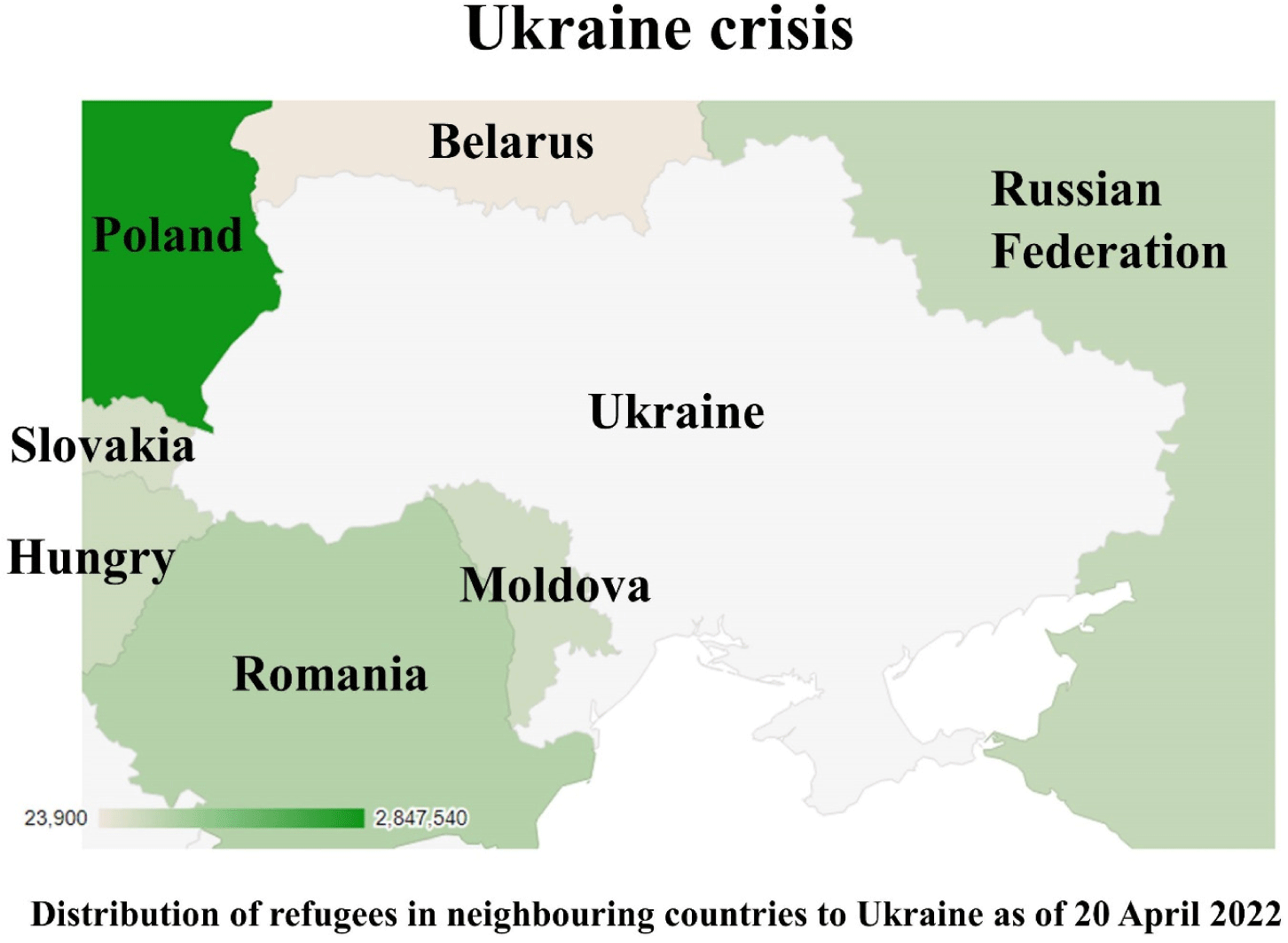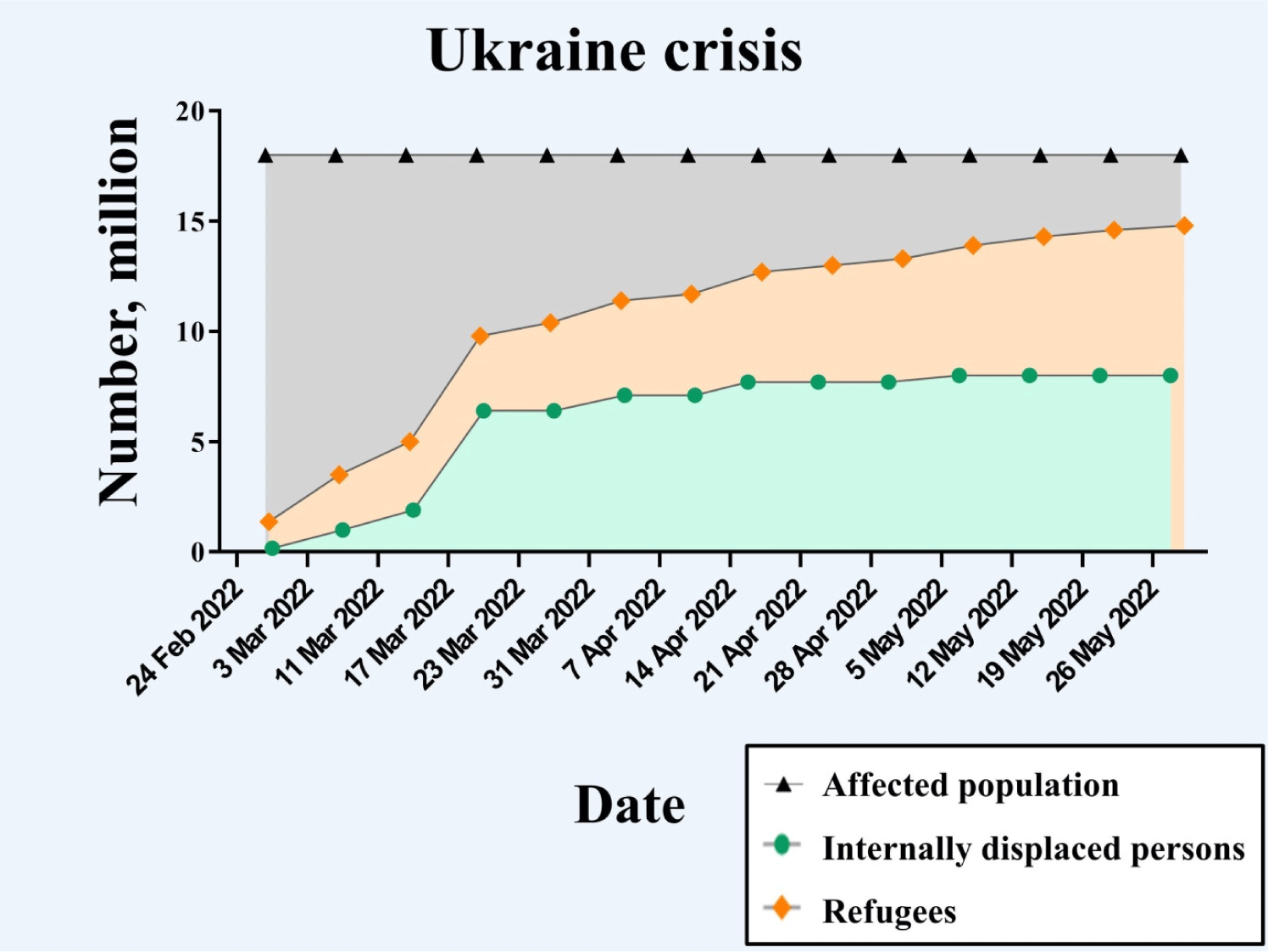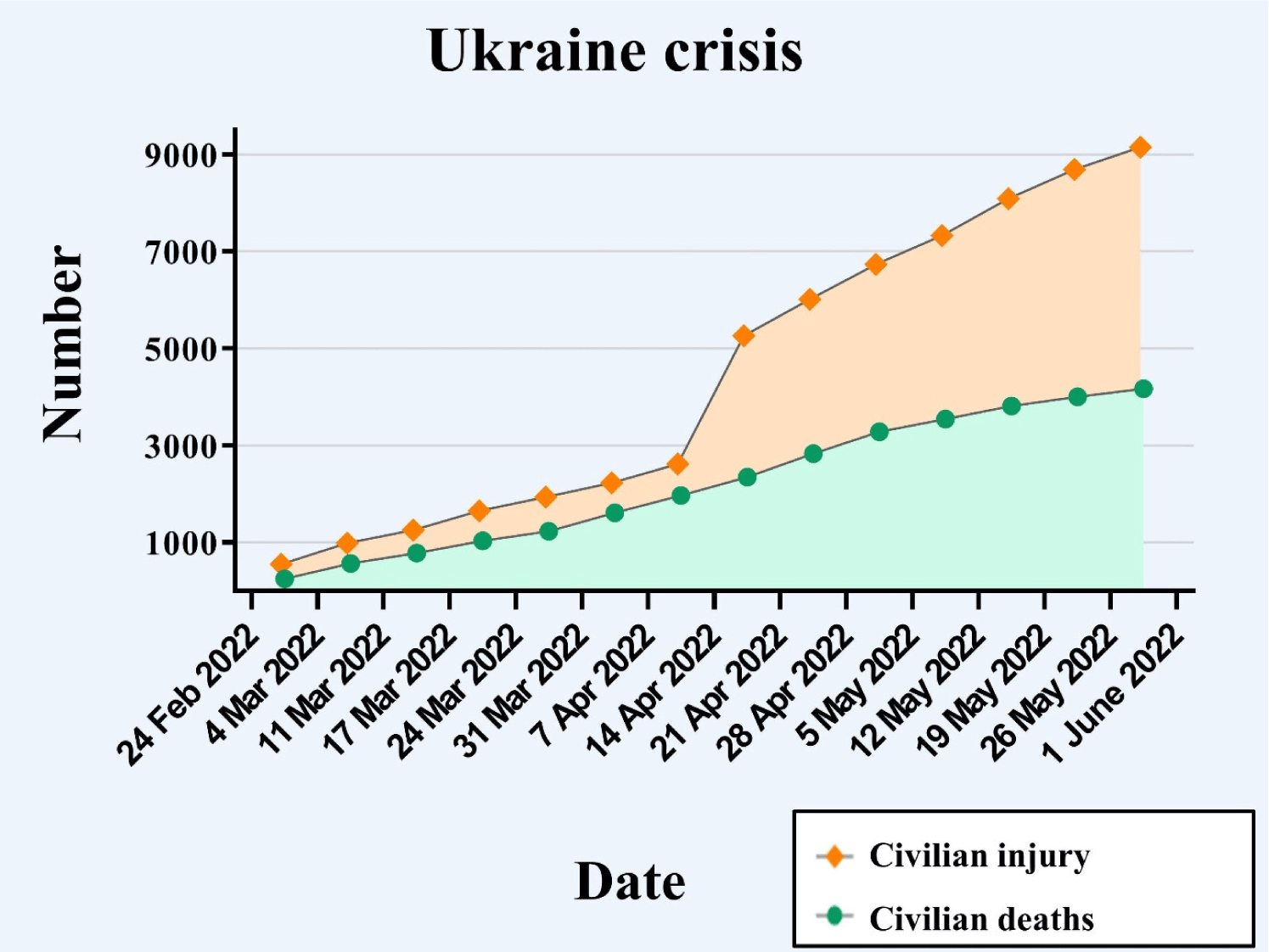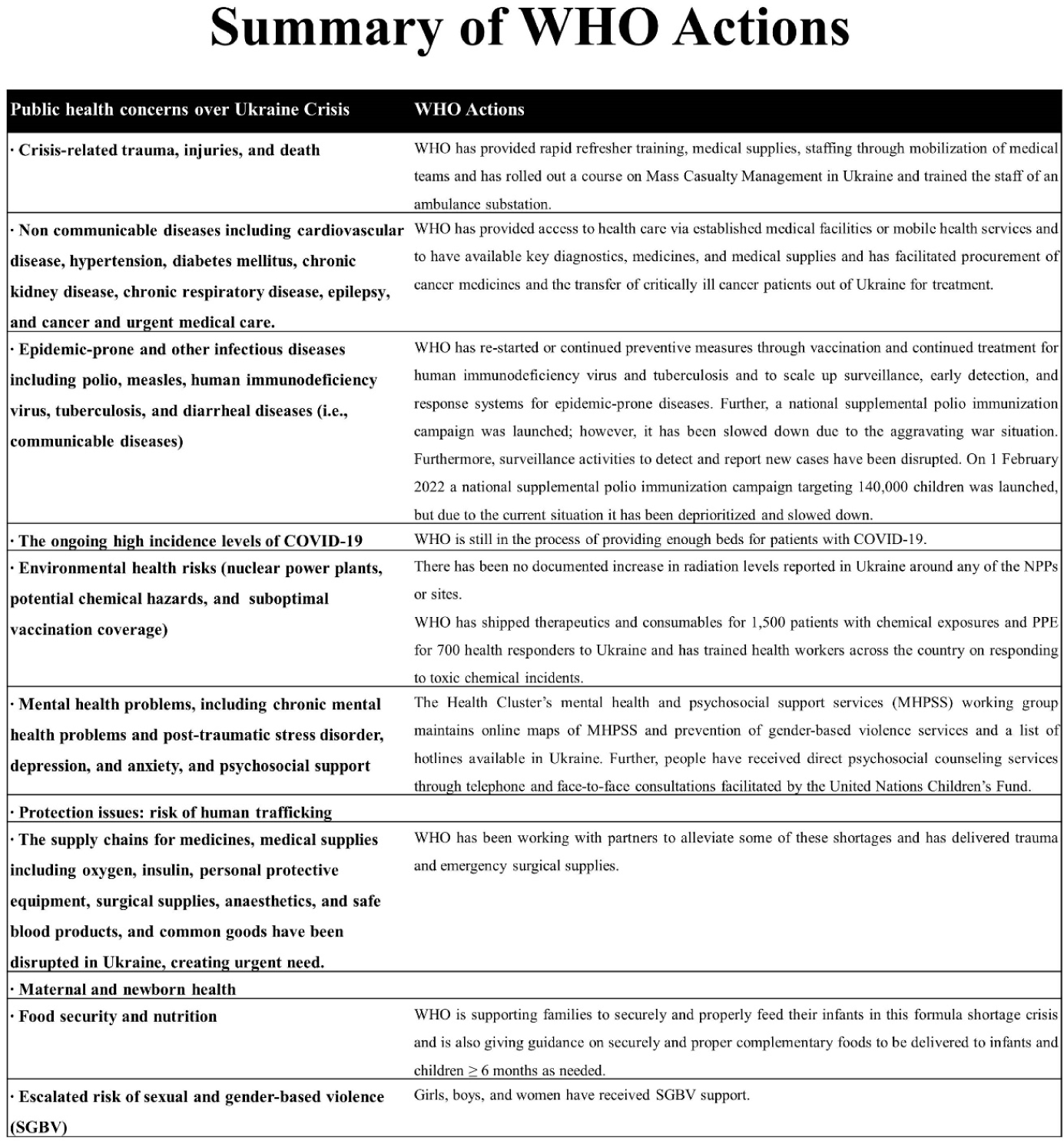1. Introduction
The sudden invasion of Ukraine by the Russian Federation on February 24, 2022 seems to have forged another 21st-century war-related catastrophe.[1] In correspondence with previous wars across the globe, it already has affected countless individuals, created refugees, forced Ukrainians to become refugees, and caused civilian injuries and deaths in Ukraine. In this regard, it calls for the international community to respond promptly to offer support, comprising medical evacuations, immediate visas, proper care and support for relocated individuals, and additional financial help to Ukraine.[2] In this review article, we outline the trends of the numbers of affected individuals, refugees, internally displaced persons (IDPs), and civilian injuries and deaths in Ukraine caused by the Russian invasion.
2. Population displacement and refugees
The world is prudently observing the war between Ukraine and the Russian Federation as the general situation progresses to languish in Ukraine. In accordance with the up-to-date governmental data assembled by the United Nations High Commissioner for Refugees (UNHCR), the projected number of the individuals influenced by the conflict is over 18 million.[3] As a result of the war, the mass migration from Ukraine is the fastest growing refugee catastrophe in the subcontinent.[4] The refugees are fleeing to neighboring countries including Poland, Slovakia, Hungary, Romania, the Republic of Moldova, Belarus, and the Russian Federation as the neighboring countries are taking their toll in taking care of the refugees (Fig. 1).[4] The number of Ukraine refugees from the first week to the 14th week escalated from 1.2 million (first week), 2.5 million (second week), 3.1 million (third week), 3.4 (fourth week), 4.0 million (fifth week), 4.3 million (sixth week), 4.6 million (seventh week), 5.0 million (eighth week), 5.3 million (ninth week), 5.6 million (10th week), 5.9 million (11th week), 6.3 million (12th week), 6.6 million (13th week), and to 6.8 million (14th week), respectively (Fig. 2).


The estimated number of the internally displaced persons (IDPs) from the first week to the ninth week into the war increased from 0.16 million (first week), 1.0 million (second week), 1.9 million (third), 6.4 million (fourth week), 6.4 million (fifth week), 7.1 million (sixth week), 7.1 million (seventh week), 7.7 million (eighth week), 7.7 million (ninth week), 7.7 million (10th week), 8.0 million (11th week), 8.0 million (12th week), 8.0 million (13th week), and to 8.0 million (14th week), respectively (Fig. 2).
The overall numbers of civilian injuries and deaths from the first week to the tenth week into the war increased from 553 and 249 (first week); 982 and 564 (second week); 1,252 and 780 (third week); 1,650 and 1,035 (fourth week); 1,935 and 1,232 (fifth week); 2,227 and 1,611 (sixth week); 2,613 and 1,964 (seventh week); 5,264 and 2,345 (eighth week); 6,009 and 2,829 (ninth week); 6,731 and 3,280 (10th week); 7,326 and 3,541 (11th week); 8,089 and 3,811 (12th week); 8,691 and 3,998 (13th week); and to 9,151 and 4,169 (14th week), respectively (Fig. 3). Of note, the number of civilian injuries escalated dramatically from the eighth through the ninth weeks (i.e., from 14 Apr through 21 Apr 2022), whereas the number of civilian deaths increased modestly during the same period.

3. Distribution of refugees in neighboring counties as of 20 April 2022s
The refugees, mostly elderly men, women, and children (men aged between 18 and 60 years old are not allowed to leave the country) from Ukraine are escaping to the neighboring countries encompassing Poland, Slovakia, Hungary, Romania, Moldova, Belarus, and the Russian Federation as the neighboring countries are taking their toll in taking care of the refugees. The numbers of refugees having entered the neighboring countries, as of 20 April 2022, are 2,847,540 in Poland; 346,175 in Slovakia; 476,213 in Hungary; 763,769 in Romania; 428,577 in Moldova; 23,900 in Belarus; and 563,266 in the Russian Federation, respectively (Table 1 and Fig. 1). Of note, we observed an abrupt increase in the number of the IDPs and the refugees from the Ukraine crisis from 17 March through 23 March 2022, which may be ascribed to the fact that after one month since beginning of the war, the Ukrainian people came to realize that the war could last much longer than they anticipated at the beginning of the war and they should seek shelter internally (i.e., IDPs) or internationally (i.e., refugees). It can be inferred that Poland is accepting more refugees (i.e., 54%, 3.1 million) from Ukraine than the other neighboring countries due to the fact that Poland is politically and economically[5] stable in the sense that its political rights and civil liberties scores are 34/40 and 47/60, respectively as of 2022 [6] and that its gross domestic product (nominal) per capita is $ 19,056 USD as of 2022, which makes Poland one of the well-to-do countries in Eastern Europe.[4]
| Country | Number of refugees |
|---|---|
| Poland | 2,847,540 |
| Slovakia | 346,175 |
| Hungry | 476,213 |
| Romania | 763,769 |
| Moldova | 428,577 |
| Belarus | 23,900 |
| Russian Federation | 563,266 |
4. World Health Organization (WHO) actions with regard to priority public health concerns over Ukraine Crisis
WHO is working in connection with the Ministry of Health of Ukraine to determine gaps and needs in the country’s health system, medical evacuations, and support response activities.[6-11] WHO has developed a rehabilitation strategy focusing on decompressing the acute trauma system and improving rehabilitation care by supporting the strengthening of designated inpatient rehabilitation facilities, which is providing guidance on addressing the nutritional needs of older people who are IDPs in Ukraine and those in reception points in neighboring countries, and is ensuring the supply of antiretroviral drugs for people living with human immunodeficiency virus (Fig. 4).

5. External communications of WHO
WHO is releasing joint United Nations Population Fund (UNFPA)/ United Nations Children’s Fund (UNICEF)/WHO statements denouncing attacks on health care workers. Stories, video clips for news outlets, and photos regarding Ukraine Crisis are available by deployed communication specialists through social media, including tweets.[6-11]
6. Funding activities
In an effort to uphold its cause, WHO launched its second updated funding appeal, for US$ 80 million in Ukraine for March-August 2022 and US$ 67.5 million for March to December 2022 in refugee-receiving and hosting countries. [6-11]
7. Conclusion
Due to the Russian illegal invasion of Ukraine on February 24, 2022, evident and dramatic increases were found in the numbers of war-affected populations, refugees, the individuals relocated in Ukraine, and civilian injuries and deaths as the war is escalated. The war has delivered great pressures and demands for the Ukrainian health division. The health shock caused by this war seems to have had effect beyond the borders of Ukraine. Over 5.3 million refugees from Ukraine have left their country seeking refuge into neighboring countries in Europe; therefore, the crisis has begun to put apply excessive pressure on human and technical resources and health systems in these neighboring countries.







